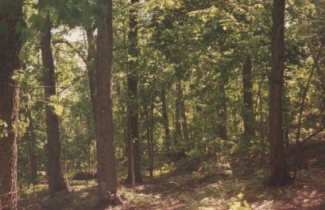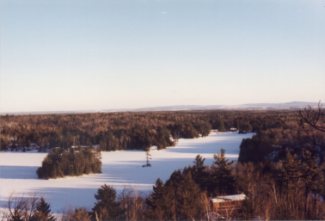|
The Laurentians
|
The Laurentians are located north of the St Laurence valley in South Western Quebec about an hour's drive from Montreal. Sometimes this area is called the Laurentian Playground because of the resorts and recreational activities that are available there. Tourism is the primary Industry there attracting many visitors from the North Eastern States and Ontario. On the weekends there is migration of people from the nearby cities of Montreal and Ottawa. Many city people own country homes around the many lakes or ski slopes that are located in this area. The people that live in the Laurentians speak primarily French, however there is a sizeable percentage of population that speaks English. There are also people of several other ethnic origins, which adds a wide variety of cultural events and festivals held in this region.
|
Some of the recreational activities that are available in the Laurentians are camping, swimming , boating, fishing, golfing, horseback riding, and without a doubt skiing, both alpine and nordic. There is fine dining in a myriad of gourmet restaurants, some of them offering wild game dishes on their menus. If you are looking to party, there is a nightlife offering live music, dancing and drinking. Find yourself a sober driver to take you back home, most of the roads are narrow hilly and curvy. Accommodations range from bring your own tent to five star bed and breakfasts and hotels.
|

|
|
The Canadian Shield or Laurentian Plateau is one of the oldest geological formations known on earth. The mountains are small and rounded at the top as a result of repeated glaciation and many years of erosion. The highest peak in the Laurentains is Mont Trembant, which has an elevation of 968 meters. To put this in perspective the mountains of the Laurentians have half to two thirds the elevation of the Appellation ranges of the Eastern United States, one third the elevation of the Alps of Europe and a quarter to that of the Rockies of western Canada and the US. Although weathered and eroded the Laurentains are quite rugged and it is possible to find cliffs and escarpments often obsured by vegetation. As a result of glaciers the soil is rocky, and one can often find rocks and boulders in unusual places such as flat valley floors lakes and swamps. This is also true for the St Lawrence valley.
|
This is a densely forested land scattered with mountains, lakes, and wetlands. Deciduous temperate forests mixed with boreal vegetation depending on soil conditions and elevations, comprise the forests of the south. Trees commonly found in these forests are various types of Maple, Birch, Elm, Aspen, and Oak. The trees of the boreal forests are conifers, including varieties spruce, pine, hemlock, balsam fir and tamarack. The coniferous trees keep their needle shaped leaves through the winter, with the exception of the tamarack that shed its needles for the winter. When the colder temperatures and shorter daylight hours of autumn arrive the leaves of the deciduous trees die, as a consequence they lose the chlorophyll which gives them the green pigmentation we see in the summer. With the loss of chlorophyll, colours of other elements in the leaves become visible giving us a colourful show much to the delight of photographers such as myself.
|


|
|
Many animals and birds make the laurentians there home. It is often possible to see squirrels and chipmunks going about their business of collecting food. Other animals like beavers, raccoons, porcupines, snowshoe hares, deer and red fox are around but they take cover at the slightest sign of human activity. Animals that cover larger territories such as moose, wolves, and black bears leave there foot prints in the forests of the laurentians. Canada geese, ducks, loons and herons migrate here in the warmer months to feed in the wetlands and lakes. Many other songbirds migrate to the Laurentians to feed on the plant and insect life that is revived when the temperature creeps up in the spring. Woodpeckers and the ruffed grouse a bird of the pheasant family live in the woodlands of the laurentians their presence may be detected by the noise they make. The ruffed grouse is interesting because it coloured so that it can be easily camouflaged and therefore
very difficult to see. This bird cannot fly, or cannot fly very well so it relies on its ability to hide to protect it self, when it has to flee danger it runs beats its wings making the sound of a muffled Harley. While waking in the woods I have almost stepped on one of these creatures and on several occasions the dog has flushed a ruffed grouse from it's hiding place but I can honestly say I have never seen one. When human noise making devices are turned off one could listen and hear the mournful call of the loon or howling wolfs and sounds made by many other animals.
|
The climate of the Laurentains varies from the extremes of the cold winter and a hot and humid summer. The temperature and humidity depend for the most part on the direction of the wind. Drier and cooler conditions are the result of winds from the north and northwest where as the south and south westerly wind bring warmer and humid weather. Winter temperatures are generally below freezing and at times the wind chill can be bitterly cold. In the late winter and early spring daytime temperatures can be warm but at night it may return to below freezing. Lakes freeze over in late November or early December and often remain frozen and ice covered late April to mid May. From May to September daytime temperatures may get quite warm and sometimes hot. Summer nights are more often than not fairly warm, but one should be prepared for the odd cool night especially when camping. Autumn days are comfortably warm while overnight it can freeze.
|

|
|
The Internet has become another way to travel the world; of course actually going to a place in person is far more rewarding. As often as possible I get in the car and drive northbound out of Montreal. An hour later I am in the beautiful countryside of the Laurentians. No matter what the season I enjoy my escape from the city if only for a day or two. With any luck in the future I will get the opportunity to travel and take pictures of other places.
|
|